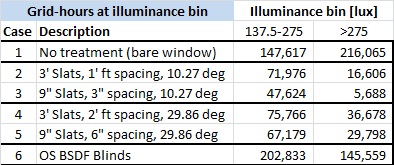I have set up 6 different simulations using Radiance. See the pic.

Cases 2 & 3 have the same width-to-spacing ratio and the same angle and the geometry is such that it blocks direct beam between 8am and 4pm year round (including DST). Same for cases 4 & 5. Yet, the results between 2 &3 differ significantly. Same between 4 & 5 . I can't understand from a physics standpoint why they are so different (even accounting for shadowing the ceiling and workplane). Why are shorter slats resulting in less daylighting?
I consulted a daylighting guy and he said they should all be equivalent (within the accuracy of the model). He suggested changing some Radiance settings and I did but the trend didn't change. Smaller, more numerous louvers still results in less daylighting.
for Case 6, I used the OpenStudio Blinds BSDF and these results are more consistent with what I'd expect. So, not only do the results seem self-INconsistent, but they seem to be 2-4 times less than what the BSDF predicts.
Any ideas of what physical concepts I might be misunderstanding or what inputs I might need to change here?






